KEBA KeContact P20, KeContact P30 User guide [ml]
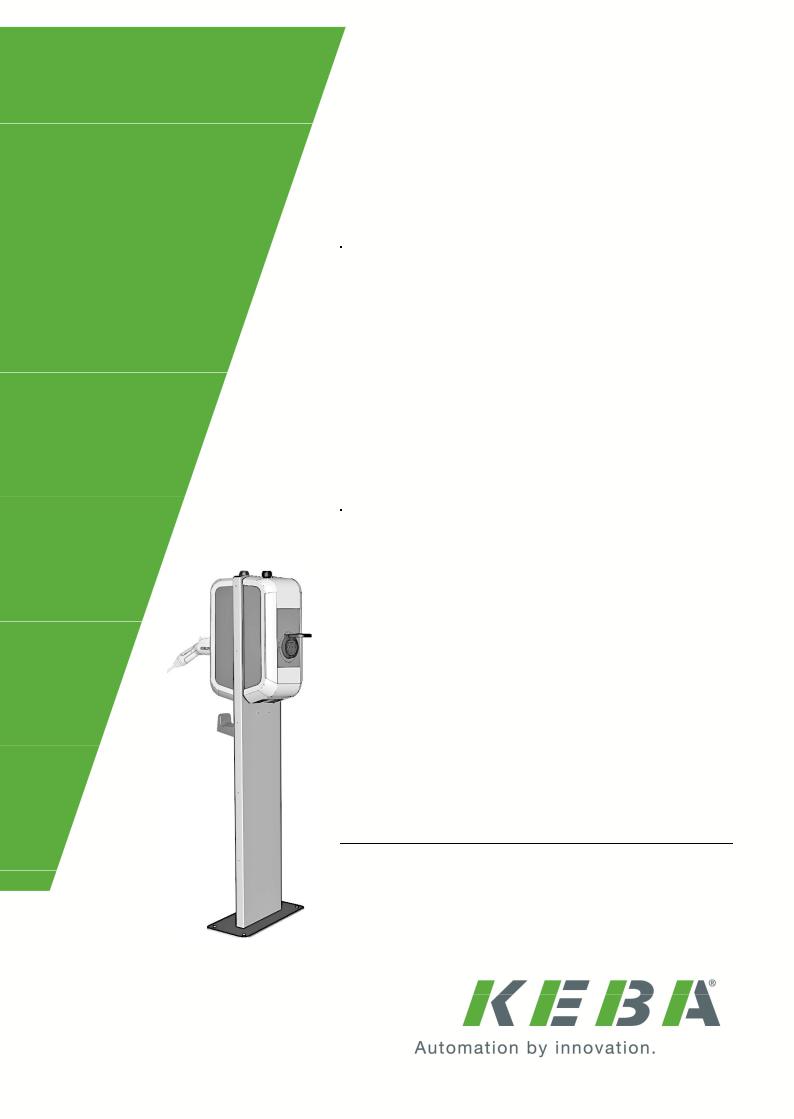
KeContact P20/P30
Standsäule – |
|
Deutsch |
|
Installationsanleitung |
|
(4) |
|
|
|
||
Floor-mounted column – |
English |
|
|
Installation guide |
(10) |
|
|
|
|
||
Colonne – |
Français |
|
|
Notice d'installation |
(16) |
|
|
|
|
||
Instrucciones de instalación |
Español |
|
|
del poste |
(22) |
|
|
|
|
||
Colonnina portante – |
Italiano |
|
|
Istruzioni per l'installazione |
(28) |
|
|
|
|
||
Standzuil – Installatiehand- |
Nederlands |
|
|
leiding |
(34) |
|
|
|
|
|
|
Coluna vertical – |
Português |
|
|
Instruções de instalação |
|
(40) |
|
|
|
|
|
- |
|
|
|
|
(46) |
|
|
|
|
|
|
|
|
|
|
– |
|
|
|
|
(52) |
|
|
|
|
|
|
© KEBA 2012-2016
Specifications are subject to change due to ongoing technical development. Errors and omissions excepted. All rights reserved.
All intellectual property, including trademarks and copyrights, is the property of the respective owner. Any unauthorized use of such intellectual property is expressly forbidden.
KEBA AG, Postfach 111, Gewerbepark Urfahr, A-4041 Linz
KeContact P20/P30 - Floor-mounted column, v2.40, #90333
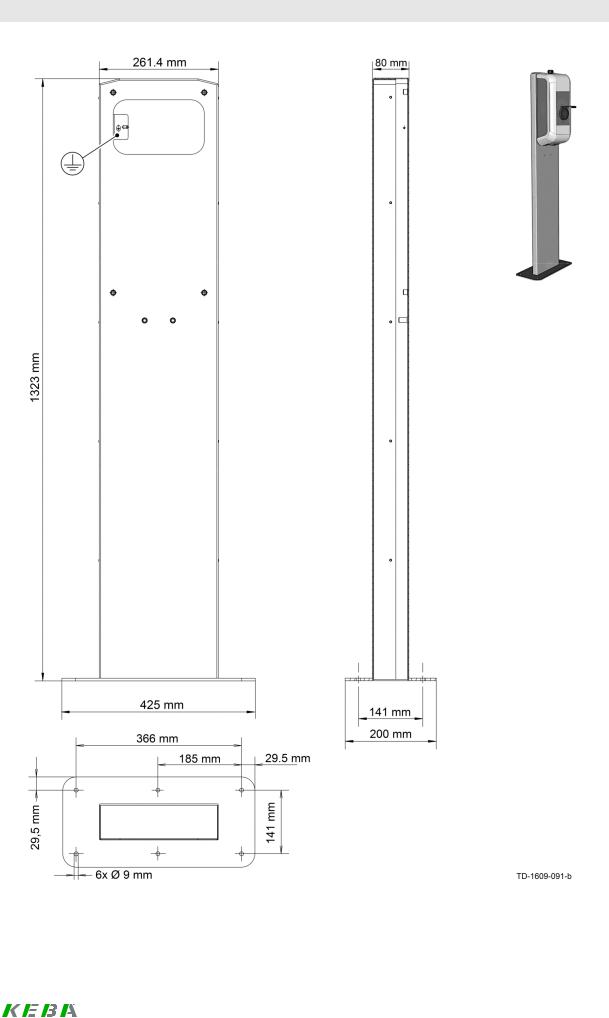
V1
2 |
KeContact P20/P30 - Floor-mounted column, v2.40, #90333 |
© KEBA 2012-2016
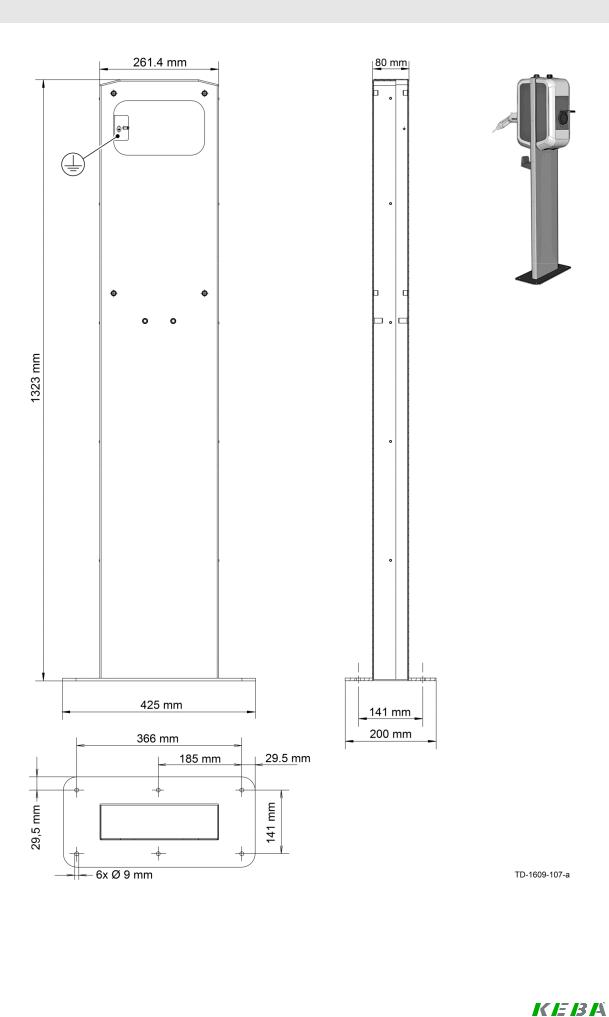
V2
KeContact P20/P30 - Floor-mounted column, v2.40, #90333 |
3 |
© KEBA 2012-2016

<![endif]>DE
Standsäule – Installationsanleitung
Sicherheitshinweise
WARNUNG!
!Nichtbeachtung der Sicherheitshinweise kann zu Lebensgefahr, Verletzungen und Schäden am Gerät führen! KEBA AG lehnt jede Haftung für daraus resultierende Ansprüche ab!
•Elektrische Gefahr!
Die Montage, erste Inbetriebnahme und Wartung der Stromladestation darf nur von einer einschlägig ausgebildeten, qualifizierten und befugten Elektrofachkraft durchgeführt werden, der dabei für die Beachtung der bestehenden Normen und Installationsvorschriften verantwortlich ist.
•Halten Sie die angeführten Vorgaben für die Standortauswahl und die baulichen Voraussetzungen ein!
Abweichungen zu den Standortvorgaben können zu Tod, schweren Körperverletzungen oder Sachschäden führen, wenn die entsprechenden Vorsichtsmaßnahmen nicht getroffen werden!
Gebrauch dieses Handbuches
Dieses Installationshandbuch wendet sich ausschließlich an qualifiziertes Personal1.
Diese Anleitung ist eine Ergänzung zum „KeContact P20/P30 Installationshandbuch“. Alle im Handbuch enthaltenen Hinweise und Anweisungen zu Standortauswahl, Montage und zum Anschluss der Stromladestation müssen beachtet werden!
Bestimmungsgemäßer Gebrauch
Alternativ zur Montage der KeContact P20/P30 Stromladestation auf einer Wand, steht eine Standsäule zur freistehenden Montage im Innenoder Außenbereich zur Verfügung.
Je nach Ausführung und Anzahl der Stromladestationen (Standsäule V1 oder V2) muss eine unterschiedliche Anzahl von Anschlusskabel und Leerrohre im Betonfundament berücksichtigt werden.
Wird die Stromladestation mit einer steckbaren Versorgungsleitung installiert (z.B. für Demonstrationszwecke), ist für die Versorgungsleitung eine ausreichende Zugentlastung sowie ein Kantenschutz vorzusehen.
Für die Montage der Standsäule sind die jeweiligen nationalen Vorschriften zu beachten.
Gewicht: 12,5 kg (ohne Stromladestation)
1 Personen die aufgrund fachlicher Ausbildung, Kenntnis und Erfahrung sowie Kenntnis der einschlägigen Normen, die übertragenen Arbeiten beurteilen und mögliche Gefahren erkennen können.
4 |
KeContact P20/P30 - Floor-mounted column, v2.40, #90333 |
© KEBA 2012-2016
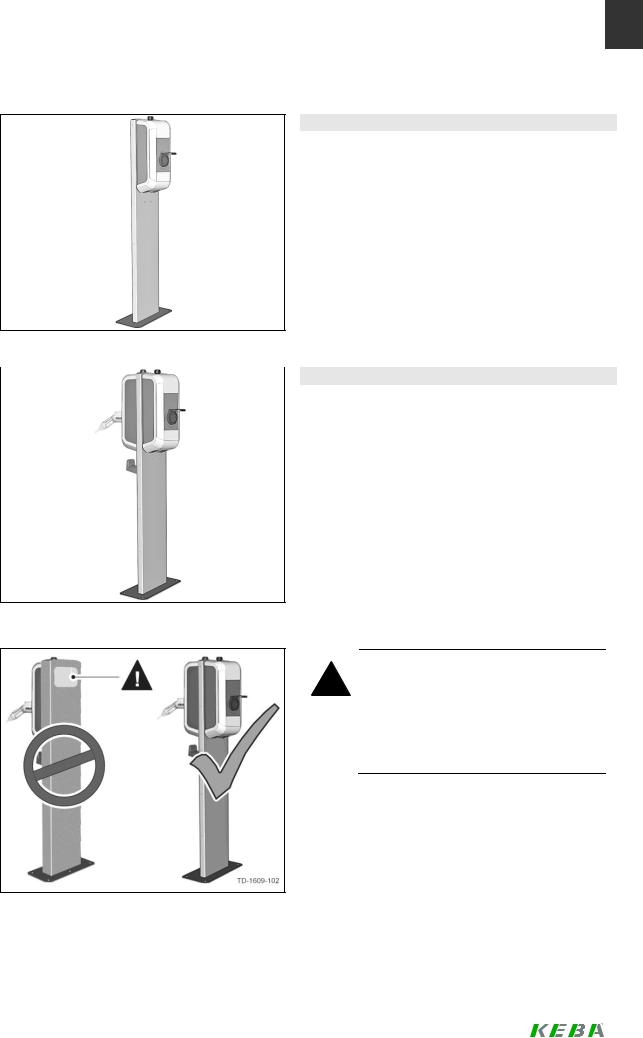
Übersicht
Standsäule V1
Standsäule V2
<![endif]>DE
Standsäule V1
Die Standsäule V1 ist für die Montage von einer KeContact P20/P30 Stromladestation auf der Standsäule geeignet.
Standsäule V2
Die Standsäule V2 ist für die Montage von zwei KeContact P20/P30 Stromladestationen auf der Standsäule geeignet.
WARNUNG!
!• Elektrische Gefahr!
Die Standsäule V2 muss immer mit zwei Stromladestationen bestückt werden! Kabelöffnungen in der Standsäule dürfen nicht offen bleiben.
KeContact P20/P30 - Floor-mounted column, v2.40, #90333 |
5 |
© KEBA 2012-2016 |
|

<![endif]>DE
Anforderungen an den Standort
Allgemeines:
·Alle Standortanforderungen für die Stromladestation aus dem „KeContact P20/P30 Installationshandbuch“ müssen beachtet werden!
·Bei der Montage der Standsäule auf Parkplätzen oder in Tiefgaragen ist bauseits ein geeigneter Anfahrschutz vorzusehen.
Betonfundament:
·Die Berechnung, Auslegung und Herstellung des Betonfundaments liegt im Verantwortungsbereich des Standortherstellers.
·Für die Aufstellung ist waagrechter, ebener und tragfähiger Untergrund erforderlich.
Um eine sichere und dauerhafte Verankerung zu gewährleisten, empfehlen wir die Ausführung eines Betonfundaments:
65cm (L) x 50cm (B), Tiefe = mind. Frostgrenze jedoch > 40cm, frostsicher gegründet. Beton: C30/37 LP für XC4, XD1, XF4 bzw. C25/30 LP für XC4, XD1, XF2
Betonstahl: BSt 500 S; BSt 500 M
·Der Untergrund muss das Ablaufen von eventuell in den Sockel gelangendem Wasser ermöglichen.
·Alle Kabel müssen genau in der Mitte des Betonfundamentes aus dem Boden geführt werden und für die weitere Montage eine Überlänge von ca. 1,5 m aufweisen.
·Bei der Herstellung des Betonfundaments sind die Kabel mit geeigneten Mitteln gegen Beschädigungen zu schützen (z.B. mit einem Schutzschlauch). Der Schutzschlauch muss eine Überlänge von ca. 25 cm über dem Betonfundament aufweisen.
·Eine Aufstellung der Standsäule auf Asphalt ist nicht zulässig!
Verankerung am Boden
Zum Verankern müssen die beigelegten Dübel verwendet werden (6 Stück Kompaktdübel Hilti HKD-ER M8x30).
|
|
|
Technische Daten |
|
M8 |
|
|
|
|
|
|
|
|
|
Ankergrund |
Normbeton ab Festigkeitsklasse |
|
|
|
|
|
C20/25-C50/60 |
|
|
|
|
Empfohlene Last |
Zug N (ungerissener Beton) |
4 |
|
|
|
|
|
|
|
|
|
Pro Dübel |
Querzug V (ungerissener Beton) |
3,9 kN |
|
|
|
|
|
|
|
|
|
Erforderlicher Randabstand |
|
10,5 |
|
|
|
|
|
cm |
|
|
|
Drehmoment Tinst |
|
≥8 Nm |
|
|
|
|
|
|
|
|
|
Bohrlochdurchmesser do |
|
10 mm |
|
|
|
|
|
|
|
|
|
Bohrlochtiefe h1 |
|
33 mm |
|
|
|
|
|
|
Spezifikation Kompaktdübel Hilti HKD-ER M8x30. Quelle: Fa. Hilti
6 |
KeContact P20/P30 - Floor-mounted column, v2.40, #90333 |
© KEBA 2012-2016
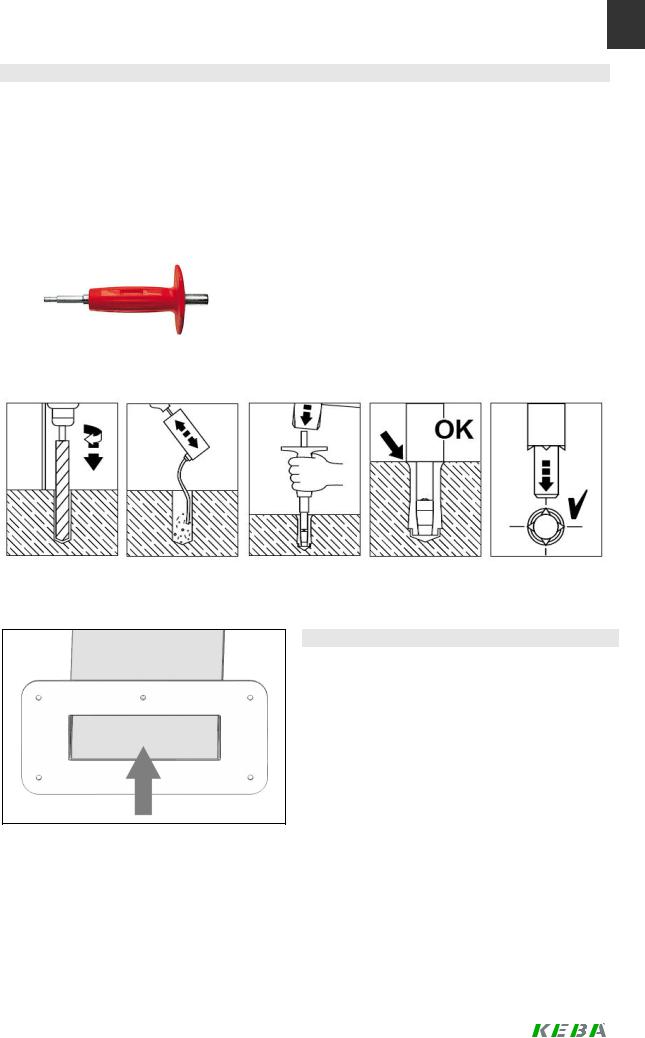
<![endif]>DE
Bohrungen durchführen
►Zeichnen Sie die 6 Bohrungen mit Hilfe der Bodenplatte der Standsäule auf dem Betonfundament an.
Stellen Sie sicher, dass sich die Anschlusskabel genau unter der Öffnung der Bodenplatte der Standsäule befinden.
►Bohren Sie die 6 Befestigungslöcher:
Durchmesser: 10 mm Bohrlochtiefe: 33 mm
►Schlagen Sie die beigepackten Dübel mit dem Hilti HSD-G Hand-Setzwerkzeug (nicht im Lieferumfang) so weit ein, dass sie mit dem Boden eben abschließen.
Hilti HSD-G Hand-Setzwerkzeug. Quelle: Fa. Hilti
Beachten Sie auch die folgende Anleitung:
Anleitung zum Setzen der Dübel. Quelle: Fa. Hilti
Kabel einfädeln
►Fädeln Sie die Anschlusskabel von unten durch die Standsäule nach oben zur Kabelöffnung.
Standsäule von unten
KeContact P20/P30 - Floor-mounted column, v2.40, #90333 |
7 |
© KEBA 2012-2016 |
|
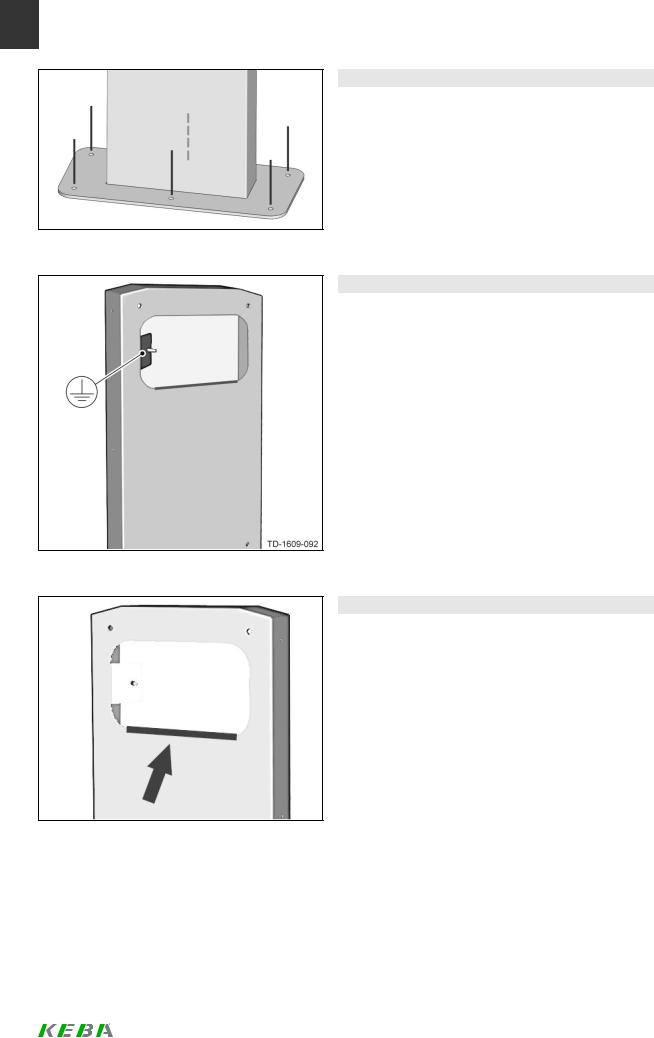
<![endif]>DE
Verankerung
► Positionieren Sie die Standsäule über dem Kabelauslass.
► Verankern Sie die Standsäule mit den 6 Sechskantschrauben am Fundament.
Verankerung
Erdungspunkt
Erdung
►Schließen Sie (falls erforderlich) die Erdung am Erdungspunkt der Standsäule an.
Kantenschutz entfernen
► Entfernen Sie den Kantenschutz an der Kabelöffnung der Standsäule erst unmittelbar vor der Montage der Stromladestation (siehe Abbildung).
Kantenschutz entfernen
8 |
KeContact P20/P30 - Floor-mounted column, v2.40, #90333 |
© KEBA 2012-2016
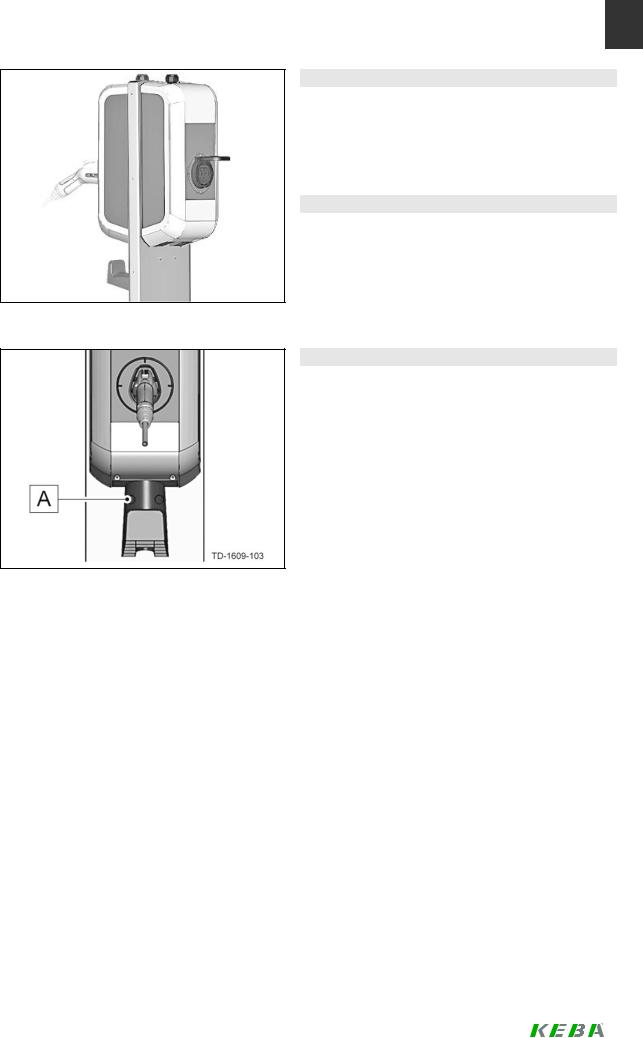
Beispiel Standsäule V2
Halterung für Ladekabel
<![endif]>DE
Stromladestationen montieren
►Montieren Sie die Stromladestationen mit den beiliegenden Schrauben auf der Standsäule.
Anschluss und Inbetriebnahme
►Führen Sie den elektrischen Anschluss und die Inbetriebnahme entsprechend der Anleitung im „KeContact P20/P30 Installationshandbuch“ durch.
Halterung für Ladekabel montieren (Option)
►Montieren Sie die Halterung für das Ladekabel unterhalb der Stromladestation mit zwei Schrauben [A] an der Standsäule.
KeContact P20/P30 - Floor-mounted column, v2.40, #90333 |
9 |
© KEBA 2012-2016 |
|

<![endif]>EN
Floor-mounted column - Installation guide
Safety instructions
WARNING!
!Not observing the safety instructions can result in risk of death, injuries and damage to the device! KEBA AG assumes no liability for claims resulting from this!
•Electrical hazard!
The installation, commissioning and maintenance of the charging station may only be performed by correctly trained, qualified and authorized electricians who are fully responsible for the compliance with existing standards and installation regulations.
•Observe the instructions given for selecting the location and the constructional requirements!
If the specifications for the location are not observed, this can result in death, serious physical injury or equipment damage if the corresponding precautionary measures are not met!
Use of this manual
This installation manual is intended for qualified personnel only2.
This guide is a supplement to the "KeContact P20/P30 Installation Manual." The information and instructions in the manual about selecting the location, installation and connection of the charging station must be adhered to.
Intended use
A floor-mounted column for free-standing installation in inside or outside areas is available as an alternative to mounting the KeContact P20/P30 charging station on a wall.
Depending on the design and number of charging stations (V1 or V2 floor-mounted columns) the relevant number of empty pipes and connection cables should be taken into consideration in the concrete foundation.
If the charging station is installed with a plug-in power supply line (e.g., for demonstration purposes), you should ensure that there is sufficient tension relief and edge protection for the power supply line.
The respective national regulations must be observed with regard to the installation of the floor-mounted columns.
Weight: 12.5 kg (without charging station)
2 Persons who, due to their special training, expertise and experience as well as knowledge of current standards, are able to assess the work performed and the possible hazards.
10 |
KeContact P20/P30 - Floor-mounted column, v2.40, #90333 |
© KEBA 2012-2016
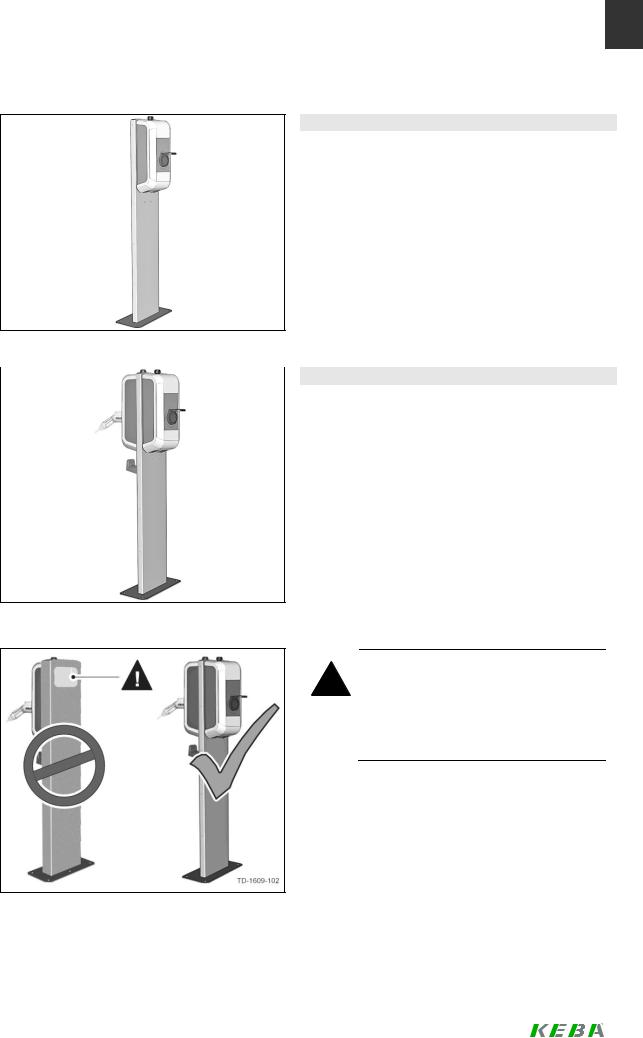
Overview
V1 floor-mounted column
V2 floor-mounted column
<![endif]>EN
V1 floor-mounted column
The V1 floor-mounted column is designed for the installation of one KeContact P20/P30 charging station on the column.
V2 floor-mounted column
The V2 floor-mounted column is designed for the installation of two KeContact P20/P30 charging stations on the column.
WARNING!
!• Electrical hazard!
The V2 floor-mounted column must always be fitted with two charging stations! There can be no open cable openings in the column.
KeContact P20/P30 - Floor-mounted column, v2.40, #90333 |
11 |
© KEBA 2012-2016 |
|

<![endif]>EN
Location requirements
General:
·All of the location requirements for the charging station in the "KeContact P20/P30 Installation manual" must be adhered to!
·When mounting the floor-mounted columns in parking spaces or parking garages, appropriate anti-collision protection must be provided by the customer.
Concrete foundation:
·The calculation, design and manufacture of the concrete founcation lies in the scope of responsibility of the producer of the site.
·A horizontal, level and sound foundation is required for installation.
To ensure safe and permanent anchoring, we recommend creating a concrete foundation:
65cm (L) x 50cm (W), depth = min. frost limit but > 40cm, frost-free. Concrete: C30/37 LP for XC4, XD1, XF4 or C25/30 LP for XC4, XD1, XF2 reinforced concrete: BSt 500 S; BSt 500 M
·The base must permit the running off of any water that has entered the base.
·All cables must be laid precisely in the centre of the concrete foundation from the base and must have an excess length of approx. 1.5 m for the remaining installation activities.
·During the production of the concrete foundation, the cables must be protected against damage using appropriate measures (e.g., a protective tube). The protective tube must have an excess length of approx. 25 cm above the concrete foundation.
·Mounting the column on asphalt is not allowed!
Anchoring to the base
The enclosed dowels must be used for anchoring (6 x Hilti HKD-ER compact dowels M8x30).
|
|
|
Technical data |
|
M8 |
|
|
|
|
|
|
|
|
|
Anchorage ground |
Standard concrete with a strength |
|
|
|
|
|
class of C20/25-C50/60 or greater |
|
|
|
|
Recommended load |
Tension N (uncracked concrete) |
4 |
|
|
|
|
|
|
|
|
|
Per dowel |
Transversal shear V (uncracked con- |
3,9 kN |
|
|
|
|
crete) |
|
|
|
|
Required clearance |
|
10,5 |
|
|
|
|
|
cm |
|
|
|
Torque Tinst |
|
≥8 Nm |
|
|
|
|
|
|
|
|
|
Drill-hole diameter do |
|
10 mm |
|
|
|
|
|
|
|
|
|
Drill-hole depth h1 |
|
33 mm |
|
|
|
|
|
|
Specifications for compact dowels Hilti HKD-ER M8x30. Source: Hilti
12 |
KeContact P20/P30 - Floor-mounted column, v2.40, #90333 |
© KEBA 2012-2016
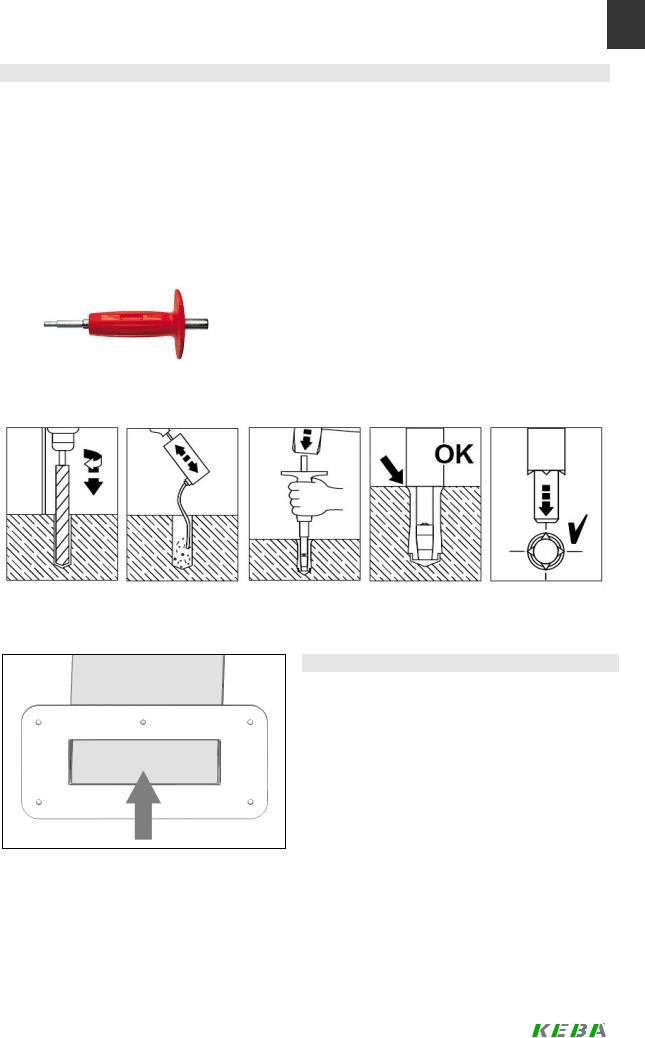
<![endif]>EN
Making drillholes
►Mark the 6 holes on the concrete foundation using the baseplate of the floor-mounted column.
Make sure that the connection cable is located precisely underneath the opening in the baseplate.
►Drill the 6 mounting holes:
Diameter: 10 mm Drill-hole depth: 33 mm
►Hammer the enclosed dowels using the Hilti HSD-G manual setting tool (not included in the scope of delivery) so that they are flush with the floor.
Hilti HSD-G manual setting tool. Source: Hilti
Please also observe the following instructions:
Instructions on inserting the dowels. Source: Hilti
Thread in cable
►Thread the connection cables from the bottom through the column upwards through the cable opening.
Floor-mounted column from below
KeContact P20/P30 - Floor-mounted column, v2.40, #90333 |
13 |
© KEBA 2012-2016 |
|
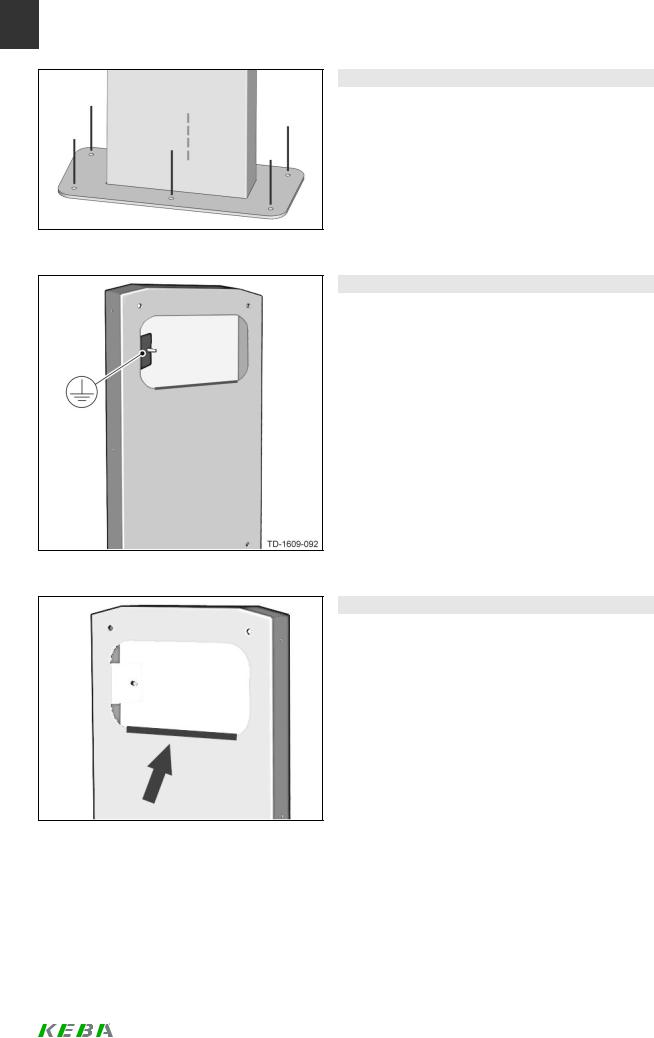
<![endif]>EN
Anchoring
► Position the column directly over the cable outlet.
► Anchor the column to the foundation using the 6 hexagon bolts.
Anchoring
Grounding
► If necessary, connect the earthing to the column's grounding point.
Grounding point
Remove edge protection
► Remove the edge protection on the cable opening of the column immediately before installing the charging station (see figure).
Remove edge protection
14 |
KeContact P20/P30 - Floor-mounted column, v2.40, #90333 |
© KEBA 2012-2016
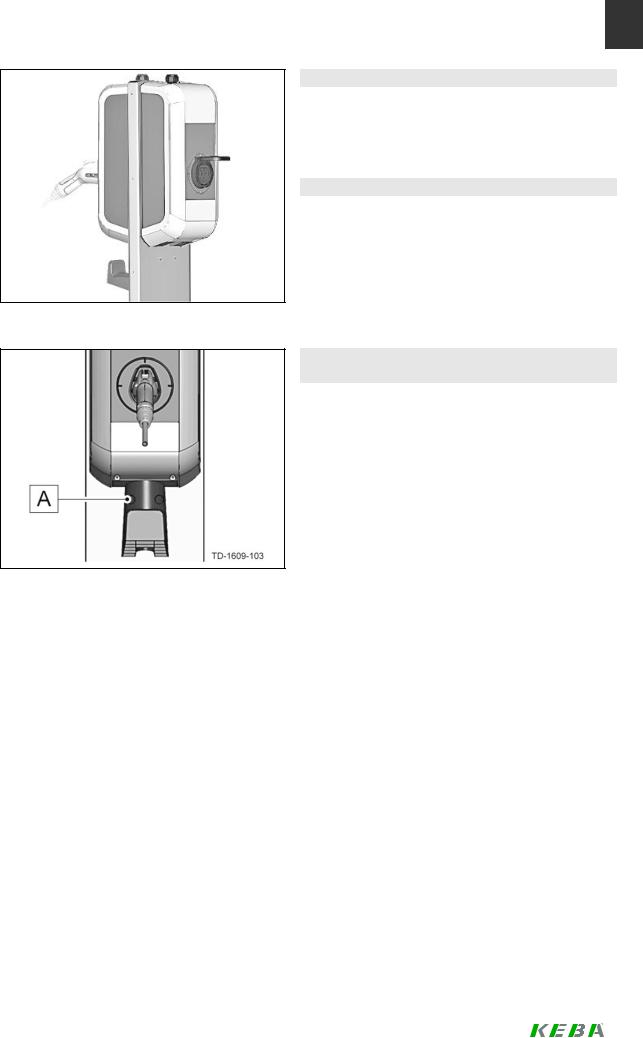
V2 floor-mounted column example
Holder for charging cable
<![endif]>EN
Mounting the charging stations
►Mount the charging stations on the column using the enclosed screws.
Connecting and commissioning
►Perform the electrical connection and commissioning in accordance with the instructions in the "KeContact P20/P30 Installation manual."
Mount the holder for the charging cable (option)
►Mount the holder for the charging cable on the floor-mounted column below the charging station using two screws [A].
KeContact P20/P30 - Floor-mounted column, v2.40, #90333 |
15 |
© KEBA 2012-2016 |
|

<![endif]>FR
Colonne – Notice d'installation
Consignes de sécurité
AVERTISSEMENT !
!Le non-respect des consignes de sécurité peut entraîner la mort, des blessures ou l’endommagement de l’appareil ! KEBA AG décline toute responsabilité pour les demandes qui en résulteraient !
•Danger électrique !
Le montage, la première mise en service et la maintenance de la station de recharge doivent être confiés uniquement à un électricien compétent, qualifié et autorisé qui porte l’entière responsabilité du respect des normes et des prescriptions d’installation existantes.
•Tenir compte des informations suivantes dans le choix du site et respecter les conditions structurelles !
Toute différence peut entraîner la mort, des blessures graves ou des dommages matériels si les mesures de sécurité correspondantes ne sont pas prises !
Utilisation de ce manuel
Ce manuel d’installation s’adresse exclusivement au personnel qualifié3.
Cette notice complète le "Manuel d'installation KeContact P20/P30". Respecter les consignes et les instructions du manuel en ce qui concerne le choix du site, le montage et le raccordement de la station de recharge !
Utilisation conforme
L'alternative au montage mural de la station de recharge KeContact P20/P30 est le montage isolé sur colonne à l'intérieur ou à l'extérieur.
Selon le modèle et le nombre de stations de recharge (colonne V1 ou V2), le nombre de câbles de raccordement et de gaines dans la fondation en béton varie.
Si la station de recharge est installée avec un câble d'alimentation enfichable (par ex. à des fins de démonstration), prévoir une décharge de traction suffisante et une protection de bord pour le câble d'alimentation.
Respecter la réglementation nationale en vigueur pour le montage de la colonne.
Poids : 12,5 kg (sans station de recharge)
3 Personnes qui, en raison de leur formation technique, de leurs connaissances, de leur expérience et de leur connaissance des normes en vigueur, sont capables d'évaluer les travaux qui leur sont confiés et d'identifier les dangers potentiels.
16 |
KeContact P20/P30 - Floor-mounted column, v2.40, #90333 |
© KEBA 2012-2016
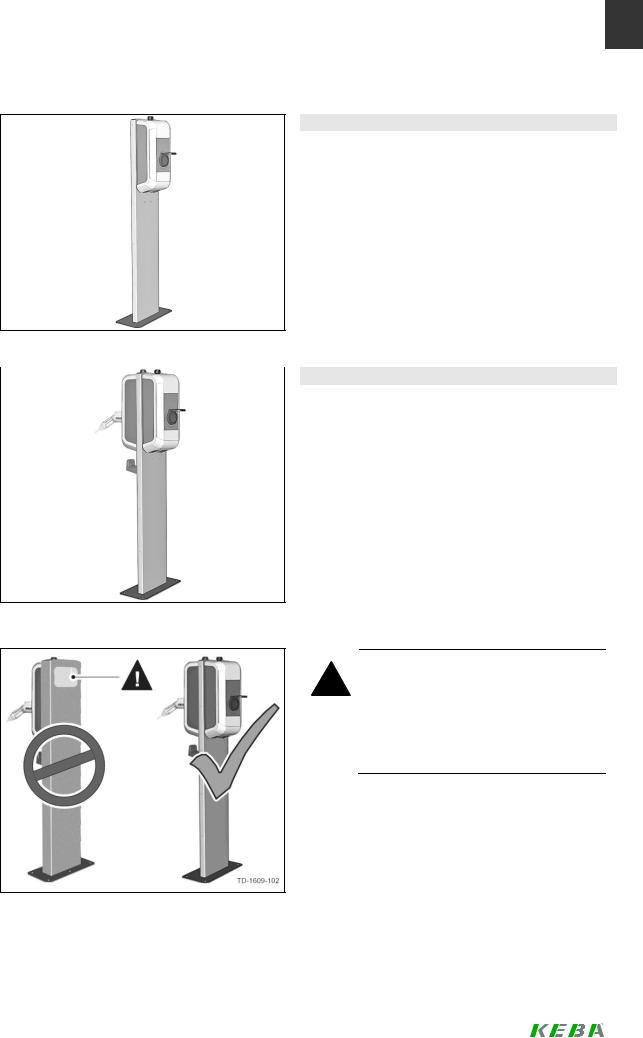
Aperçu
Colonne V1
Colonne V2
<![endif]>FR
Colonne V1
La colonne V1 convient au montage d'une station de recharge KeContact P20/P30.
Colonne V2
La colonne V2 convient au montage de deux stations de recharge KeContact P20/P30.
AVERTISSEMENT !
!• Danger électrique !
La colonne V2 doit toujours être équipée de deux stations de recharge ! Les ouvertures de câble de la colonne ne doivent pas rester ouvertes.
KeContact P20/P30 - Floor-mounted column, v2.40, #90333 |
17 |
© KEBA 2012-2016 |
|

<![endif]>FR
Exigences sur site
Généralités
·Respecter toutes les exigences relatives au site pour la station de recharge qui figurent dans le "Manuel d'installation KeContact P20/P30" !
·Si la colonne est installée dans un parking ou dans un garage souterrain, prévoir une protection contre les collisions adaptée.
Fondation en béton
·Le constructeur du site est responsable de l'élaboration, de la conception et de la construction de la fondation en béton.
·L'installation exige un support horizontal, plan et résistant.
Pour garantir un ancrage sûr et durable, construire une fondation en béton ingélive dont les caractéristiques sont les suivantes :
65 cm (longueur) x 50 cm (largeur), profondeur = au moins limite du gel mais > 40 cm. Béton : C30/37 LP pour XC4, XD1, XF4 ou C25/30 LP pour XC4, XD1, XF2
Béton armé : BSt 500 S ; BSt 500 M
·La fondation doit permettre l'évacuation de l'eau éventuellement présente dans la semelle.
·Tous les câbles doivent ressortir du sol exactement au milieu de la fondation en béton et dépasser d'env. 1,5 m pour poursuivre le montage.
·Lors de la construction de la fondation en béton, protéger les câbles contre les dommages à l'aide d'accessoires adaptés (par ex. une gaine). La gaine doit dépasser de la fondation en béton d'env. 25 cm.
·L'installation de la colonne sur l'asphalte n'est pas autorisée !
Ancrage au sol
Pour l'ancrage, utiliser les chevilles fournies (6 chevilles compactes Hilti HKD-ER M8x30).
|
|
|
Caractéristiques techniques |
|
M8 |
|
|
|
|
|
|
|
|
|
Support d'ancrage |
Béton normalisé à partir de la classe |
|
|
|
|
|
de résistance C20/25-C50/60 |
|
|
|
|
Charge recommandée |
Traction N (béton non fissuré) |
4 |
|
|
|
|
|
|
|
|
|
Par cheville |
Traction transversale V (béton non fissu- |
3,9 kN |
|
|
|
|
ré) |
|
|
|
|
Distance du bord nécessaire |
|
10,5 |
|
|
|
|
|
cm |
|
|
|
Couple de serrage Tinst |
|
≥8 Nm |
|
|
|
|
|
|
|
|
|
Diamètre de perçage do |
|
10 mm |
|
|
|
|
|
|
|
|
|
Profondeur de perçage h1 |
|
33 mm |
|
|
|
|
|
|
Spécifications des chevilles compactes Hilti HKD-ER M8x30. Source : Sté Hilti
18 |
KeContact P20/P30 - Floor-mounted column, v2.40, #90333 |
© KEBA 2012-2016
